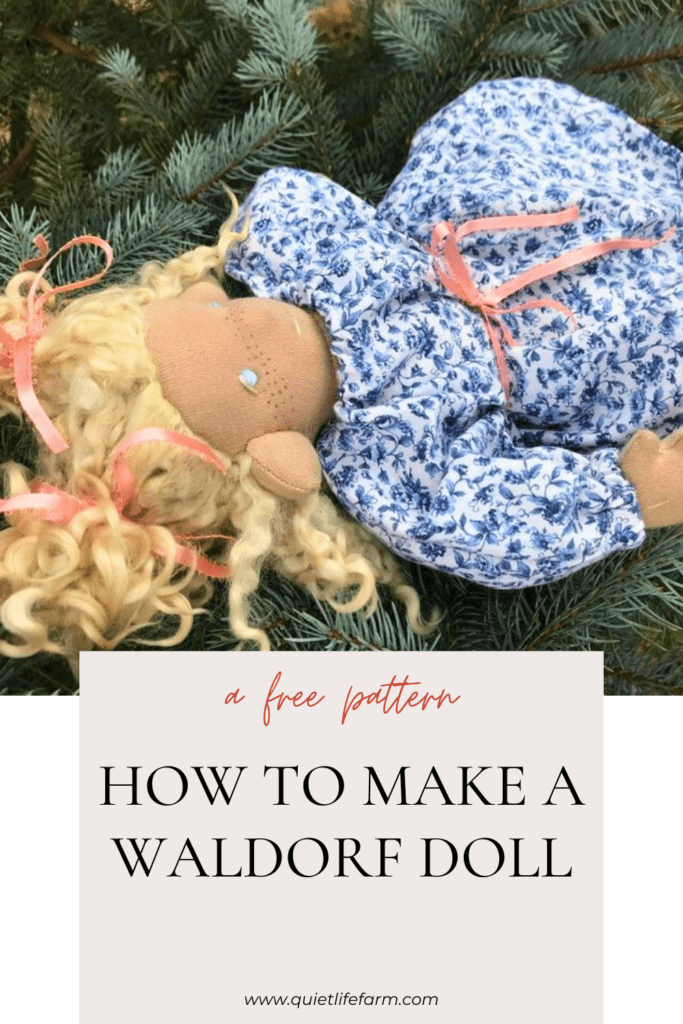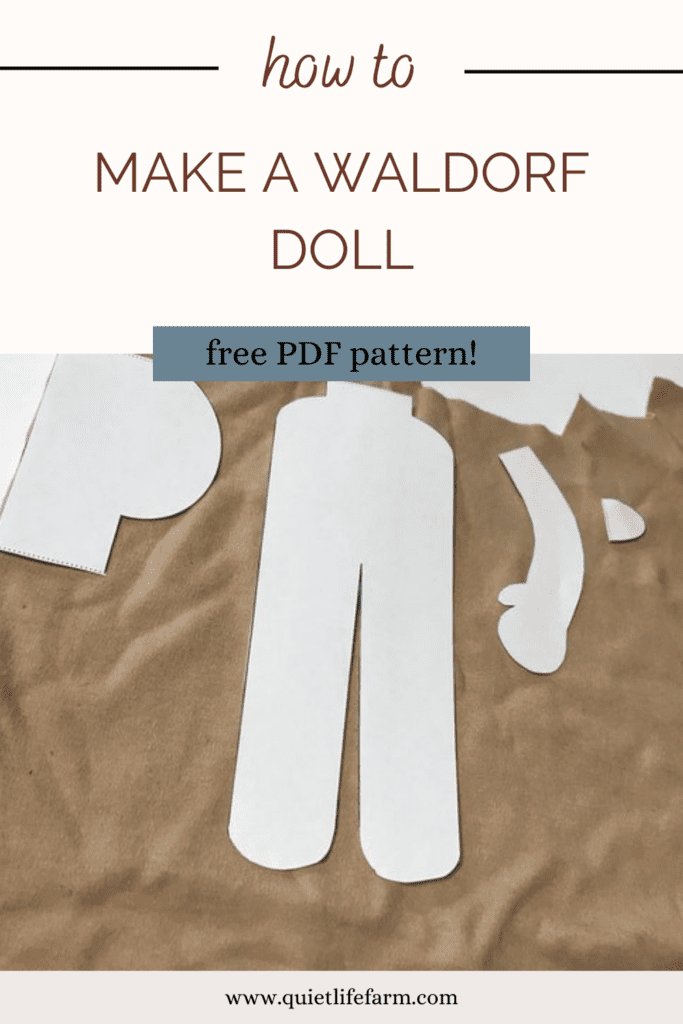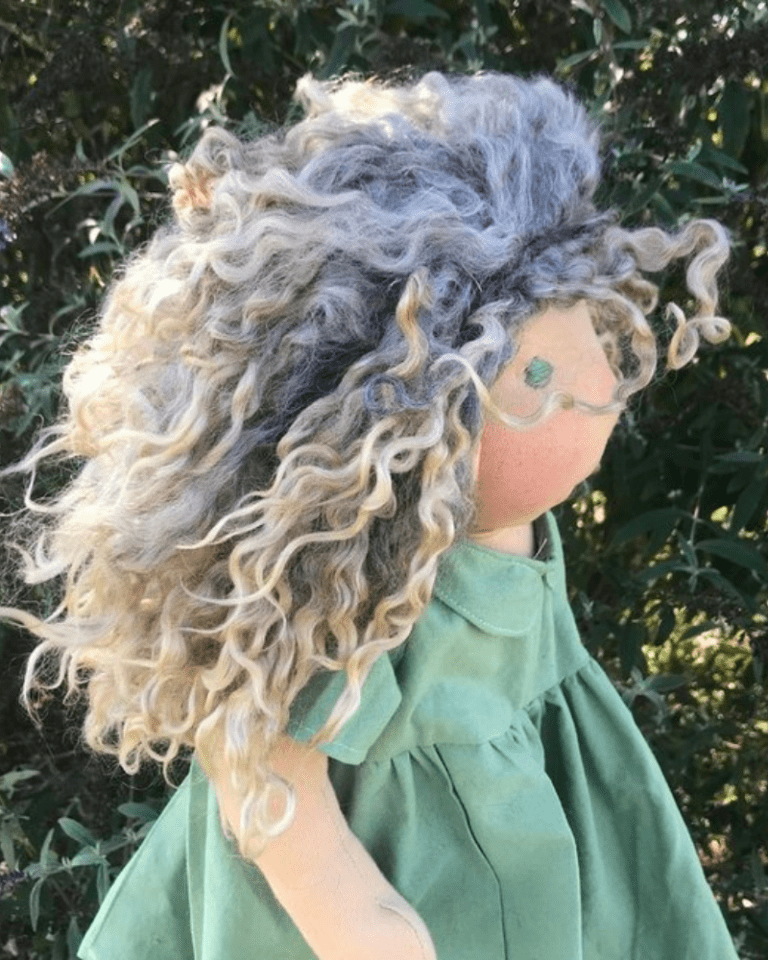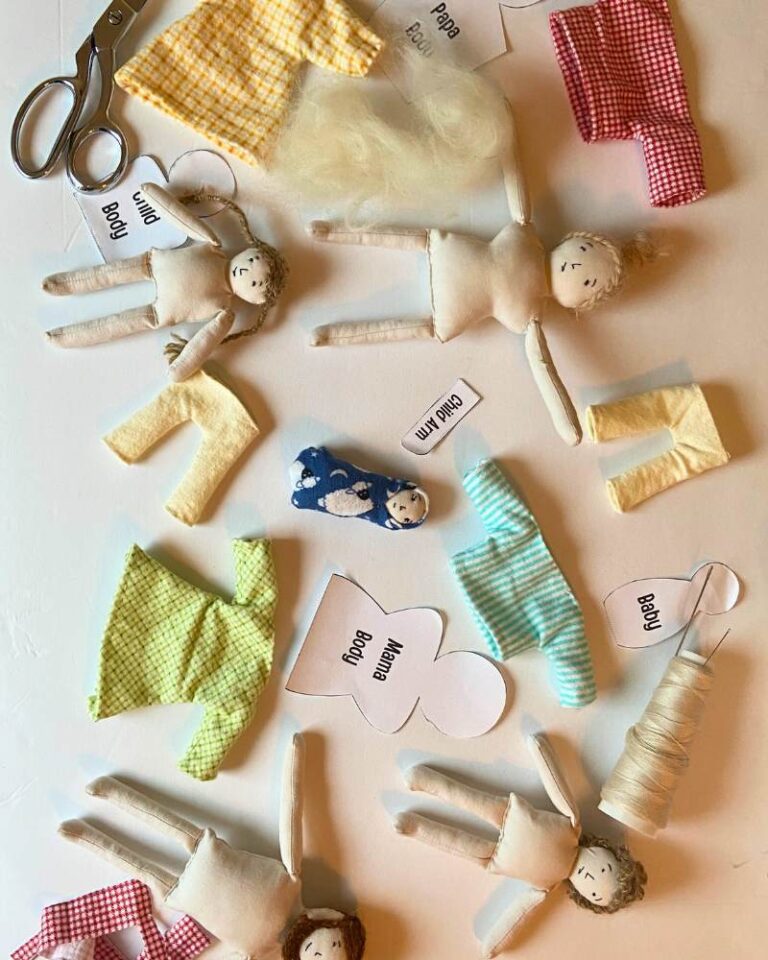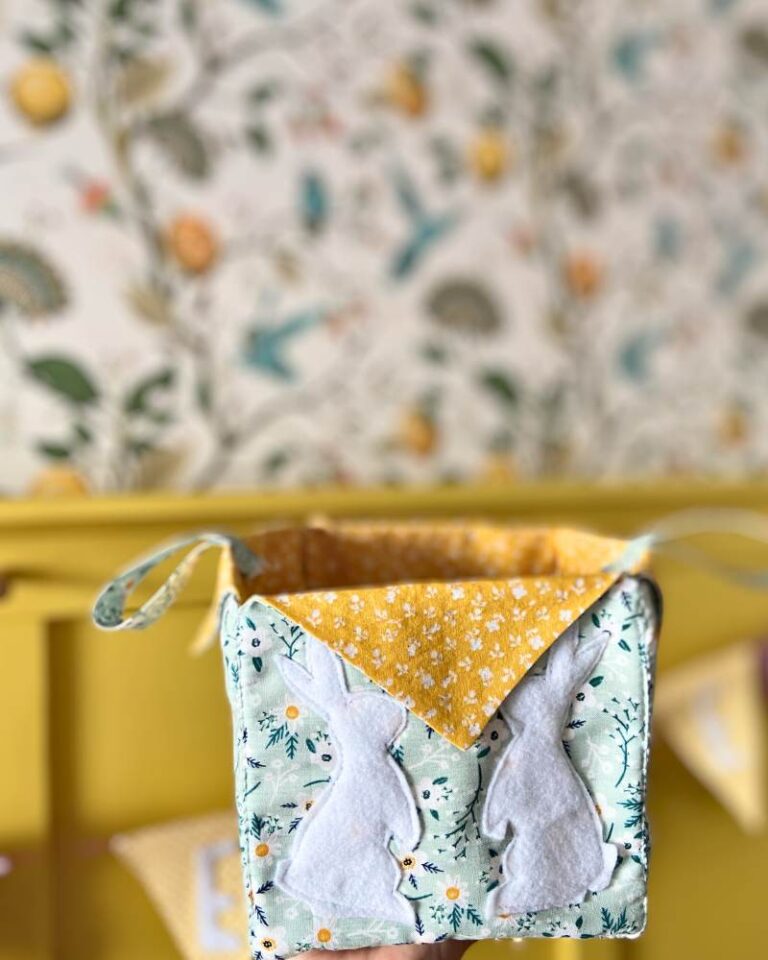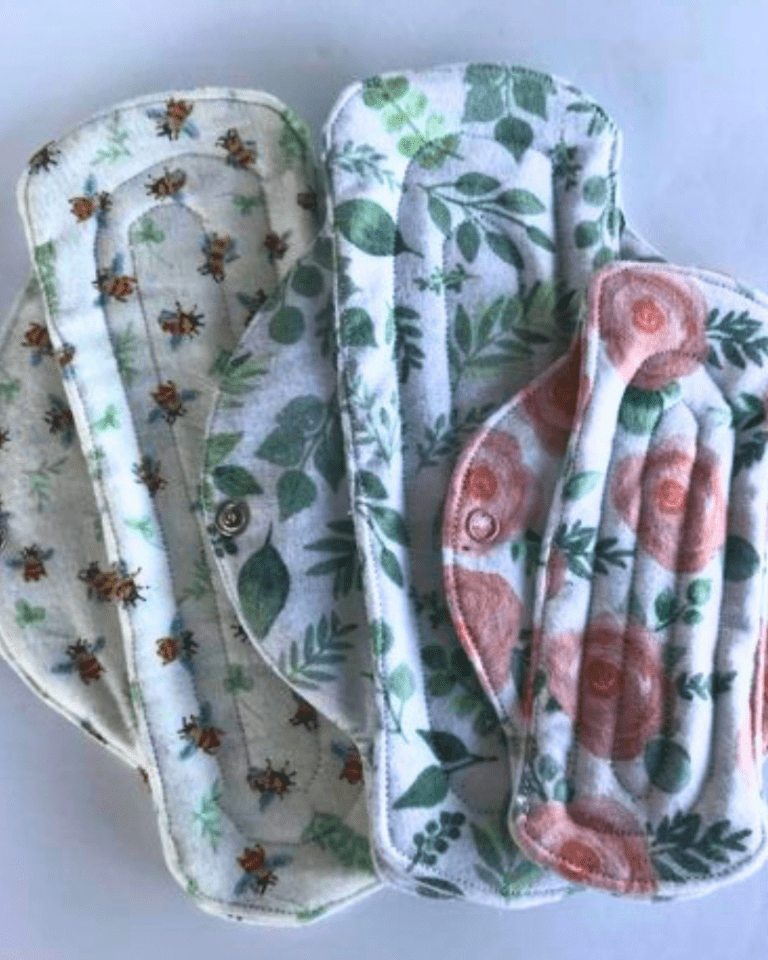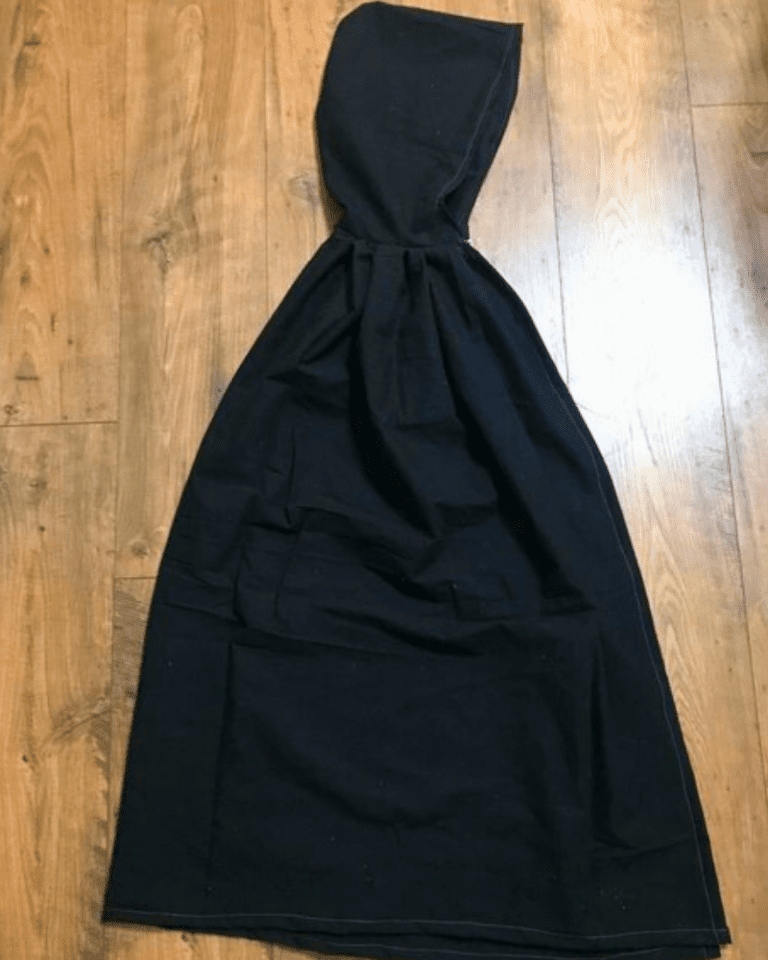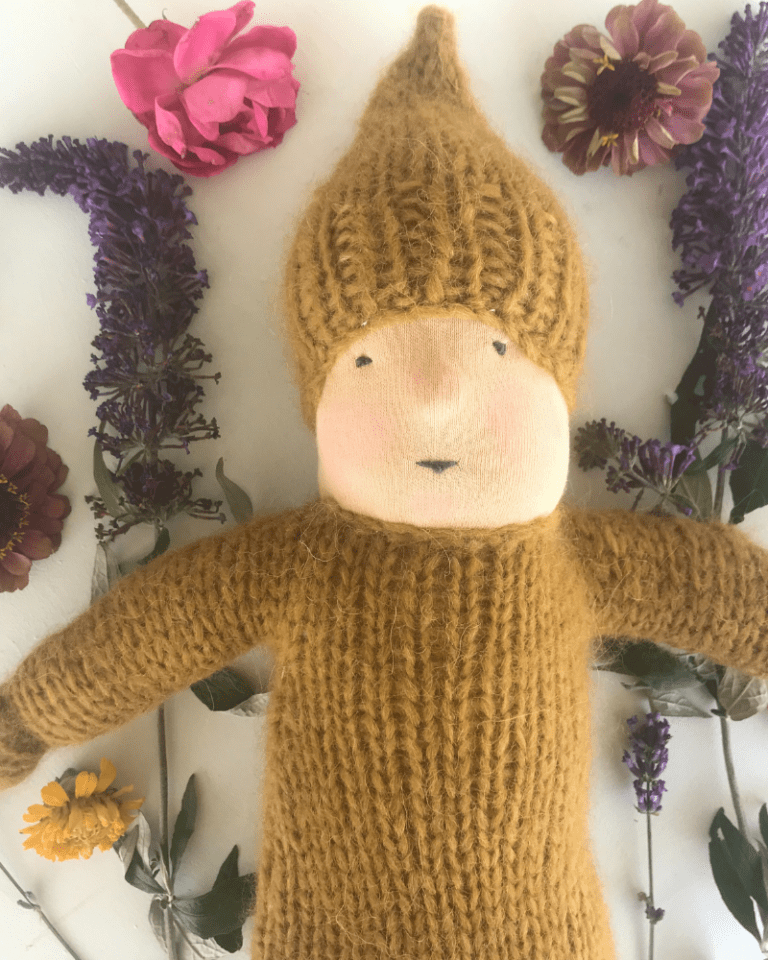Waldorf Doll Free PDF Sewing Pattern
I hope you enjoy this free pattern for a sweet and easy to make waldorf doll! Scroll on down for a complete photographed tutorial.
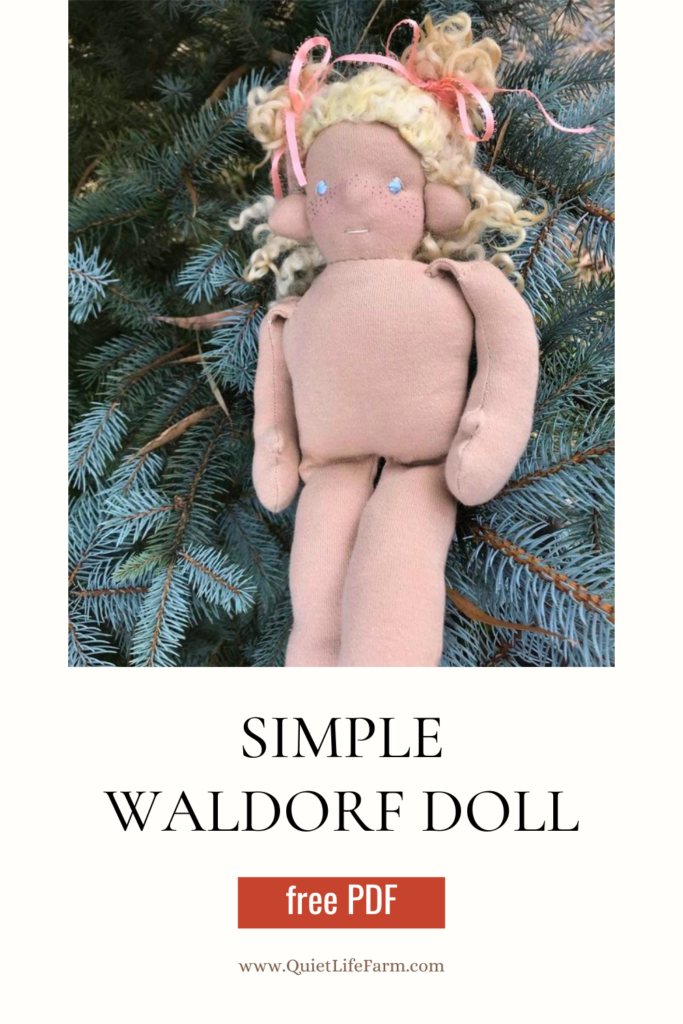
I made this Waldorf Doll for a friend’s daughter. I think she is so sweet (and so is the doll!)
This doll has a traditional Waldorf doll style face with no felting.
I added a few extra embroidered features to the face, but you can always just make two simple eyes with a french knot.
This pattern is free and printable, instantly ready to use!
Print out your pattern, then head back over to my blog for a complete walk through on how to make this doll!
Disclaimer: As an Amazon Associate, I earn a small commission from qualifying purchases at no extra cost to you.
Supply List
For this doll, you will need:
- Cotton Interlock Fabric in a skin color of your choice. I used this in “tan,” but the fabric from Weir Crafts is still my favorite!
- wool for stuffing your doll
- Something for the hair (yarn, a weft…)
- 6.5mm crochet hook and worsted weight yarn in a similar color to the hair
- Unwaxed Dental floss for shaping the head
- 2 1/4″ gauze tubing to make the inner head with
- Needle and thread, plus a sewing machine
- Dollmaking needle (a nice long strong needle with a large eye)
- Embroidery floss and an embroidery needle to create facial features
- Straight pins for pinning hair into place
- A super fine permanent marker and a (red) crayon for creating freckles and blush on the doll
- Lastly, you’ll of course need my free printable PDF pattern!
Step 1: Trace, Sew, and Cut your pattern.
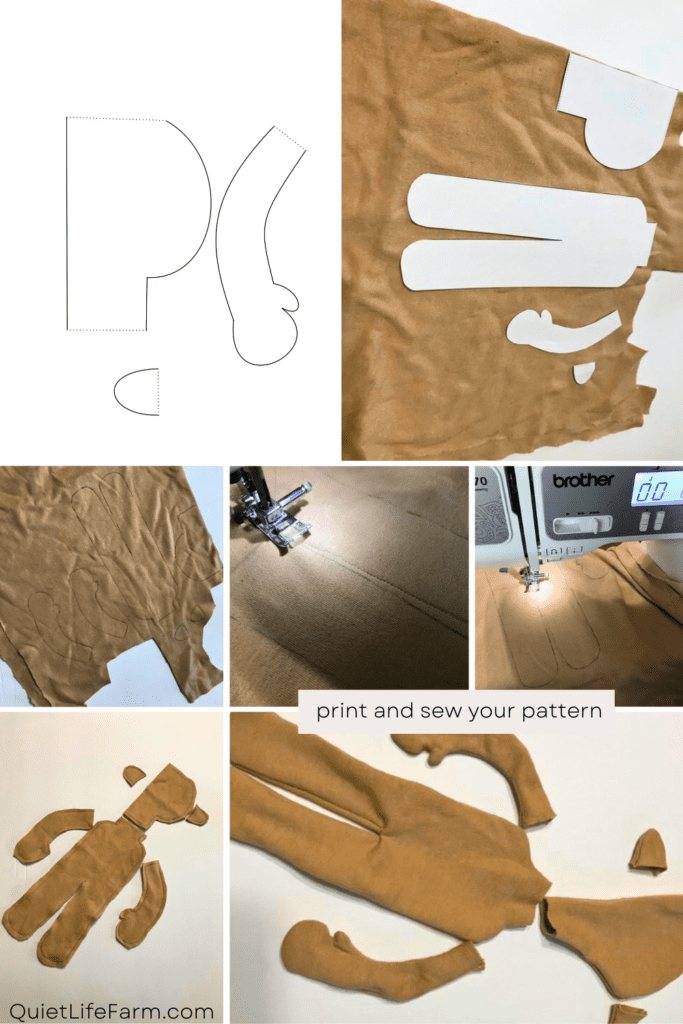
First, you’ll need to print out your pattern. Get it below (totally free!):
Fold your cotton interlock fabric in half.
Trace your pattern pieces over the two layers of fabric, making sure your head is traced on the fold of the fabric.
Leave 1/2″ space between each pattern piece you trace.
Make sure the stretch goes in the direction that would make your doll appear wider, not taller.
I just use a regular old pencil to trace my patterns! You might prefer something different, but consider whether or not what you choose to trace the patterns with will show/bleed through the fabric and make a mess!
Sew right on the lines you traced — through both layers of fabric.
Leave the dotted line portions OPEN.
Make good strong knots (lots of back stitches on your sewing machine!) when starting and finishing your seams.
You may even wish to sew a second set of stitches directly over your first stitches! This will make your doll hold up even better over the years!
Cut out all of your sewn pieces, leaving a 1/4″ seam allowance.
When you cut around your thumbs and legs, cut carefully as the seams come close together! You want to cut far enough so there is good mobility, but not so far that your stitches will come apart. These are areas where it’s really good to sew a second time right on top of your first stitches.
If you feel that you’ve cut too close to your seams, don’t fret. Just sew a second line of stitches right on top of your first seams, or slightly inside from them.
Step 2: Begin to stuff your doll with wool
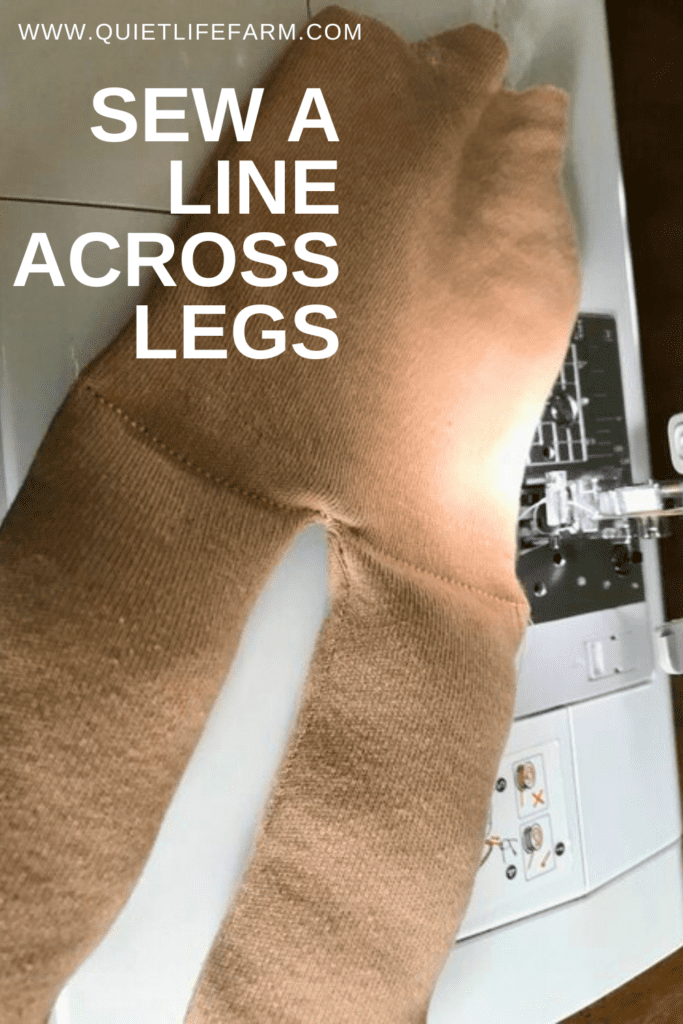
Now, we’ll start stuffing your doll with wool!
Some of the wool I am putting into this doll was purchased on Amazon, and some of the other wool is from my sheep.
“Fluff” each little piece of wool before putting it into the doll.
Turn all your sewn fabric pieces right side out.
I find it helps to gently use the blunt end of a large knitting needle to help turn out all the corners.
Stuff the legs, and sew a line across the top of each leg. This creates extra “mobility” for the legs.
Then, stuff the rest of the body.
Sewing the arms
Stuff the arms with wool, making sure to get enough wool in each thumb.
Stop stuffing the arm an inch before reaching the top.
Again, a large knitting needle or slim wooden spoon really helps with this part!
Sew a line of stitches across the empty 1″ top, to keep the wool pushed down.
Then, sew a second line of stitches at the very tippy top of the arm.
Set the arms aside.
Ears
Stuff each ear with wool.
Fold the raw edges of the ear inside the ear.
Sew a line of stitches at the very edge of the ear to keep it closed.
You’ll want to sew this part by hand.
Set aside the ears.
Careful not to lose them!
Step 2: Make the Inner Head
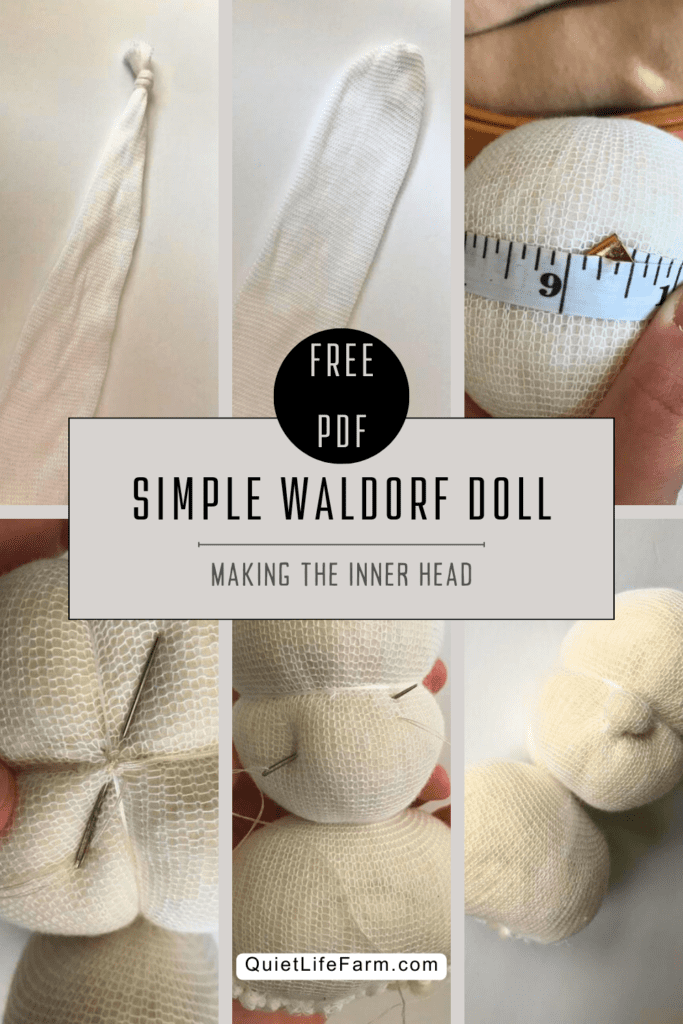
Now we’ll start working on the head of your doll!
Grab some gauze tubing for the inner head of your doll. You’ll want some that is 2 1/4″ wide. The length should be 12″ (cut your gauze to length!)
Tie a knot at the end of the tubing, then turn the tubing inside out.
Stuff the gauze tubing with some wool to create a nice firm, round head. The head should measure 9″ in all directions.
Tie around the “neck” with some unwaxed dental floss.
Stuff some wool into the bottom portion of the gauze for a neck, then sew a line of stitches at the bottom of the neck to hold the “neck wool” into place.
Use your unwaxed dental floss to divide the head into fourths:
- first, tie some dental floss around the head horizontally, right in half.
- then, tie some dental floss around the head vertically, right in the middle of the head.
At the “x” where the dental floss meets at the sides of the head, sew some stitches to hold the floss in place.
Use your hand sewing needle to weave in all the loose ends of thread and dental floss inside the wool dryer ball head before snipping off the excess.
Nose
Use a needle and thread to create a nose on your doll.
Weave your needle in and out, going in a circle where you want your nose (it should be right below the eyeline in the center of the face!).
Pull up a little wool from in the face with each stitch.
Pull the thread tight so that the gauze tubing and wool bunches up, creating a tiny nose.
Sewing on the head fabric
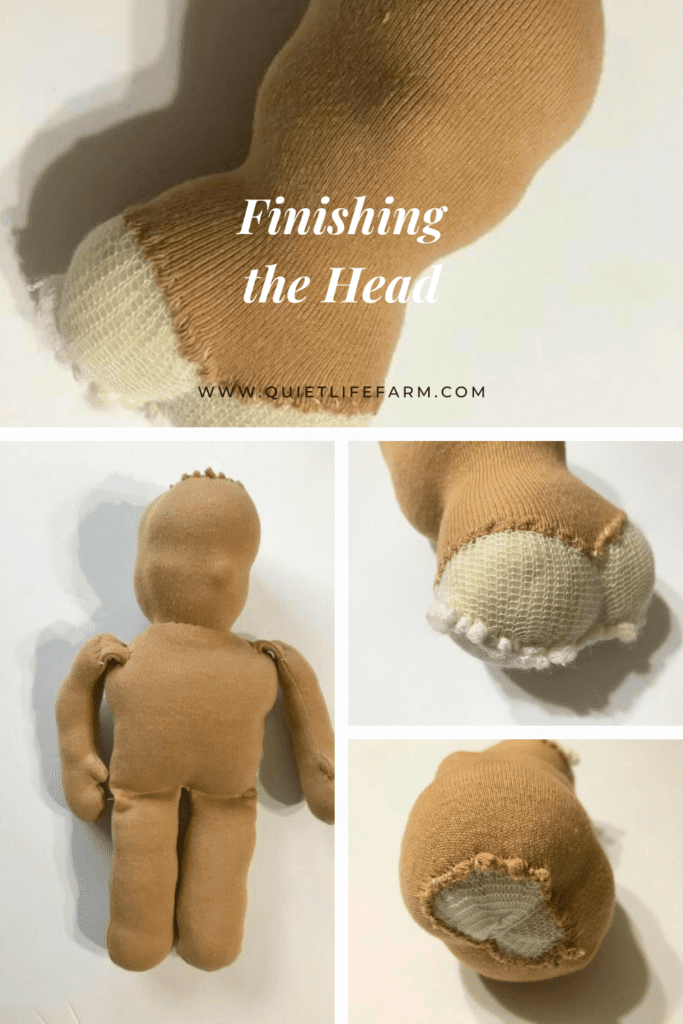
Now we’ll put the “skin” of the doll over the inner head.
With the head pattern piece right side out, place it over the doll’s head.
Start with the neck going into the large hole at the top of the head, and then pull the fabric over your doll’s inner head.
Be sure the seam is on the back of the head!
Smooth out the fabric, and sew the fabric down to the top of the head.
Make sure to leave as few wrinkles as possible! Any wrinkles that are unavoidable should be made towards the back of the head where they will be hidden by the doll’s hair.
Then, pull the fabric around the neck down to cover the “inner neck” created with the bottom portion of the sock. Sew around, again creating a nice smooth area.
Pulling the fabric down around the neck should also help the neck no longer appear “floppy.” This step helps strengthen the neck up!
Finish assembling the doll’s body
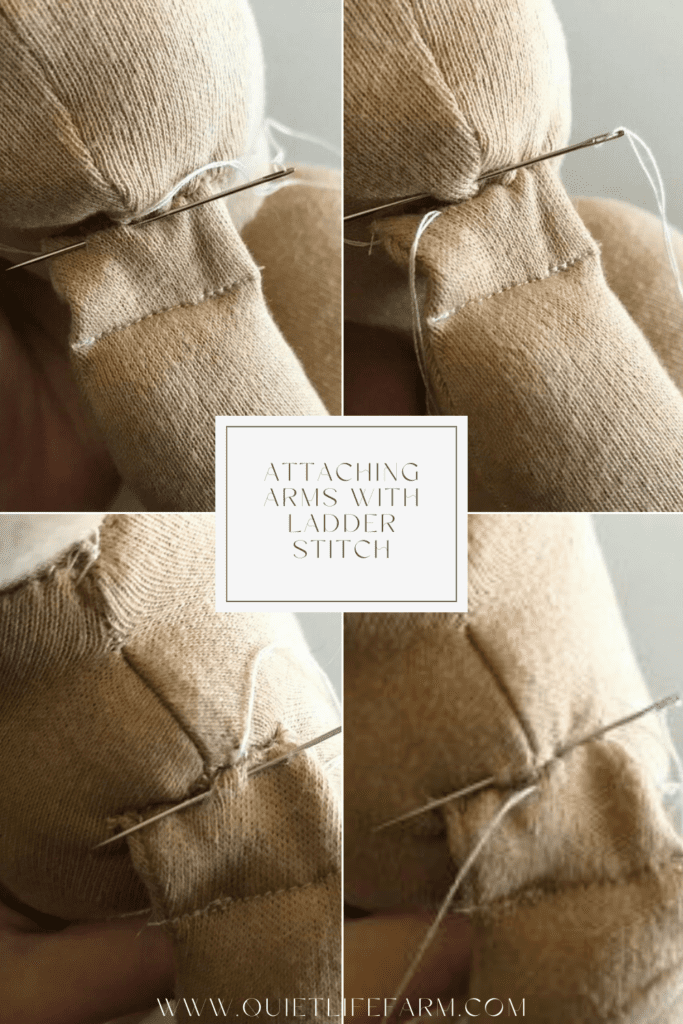
Next, fill the torso with wool. (if you haven’t already!)
Stick the neck into the body and position the head so it’s straight.
Stuff some extra wool into the shoulders after inserting the neck into the body.
Use a ladder stitch at the neck to sew the head/neck to the body.
Lastly, attach the arms using a ladder stitch.
Embroidering the eyes and mouth
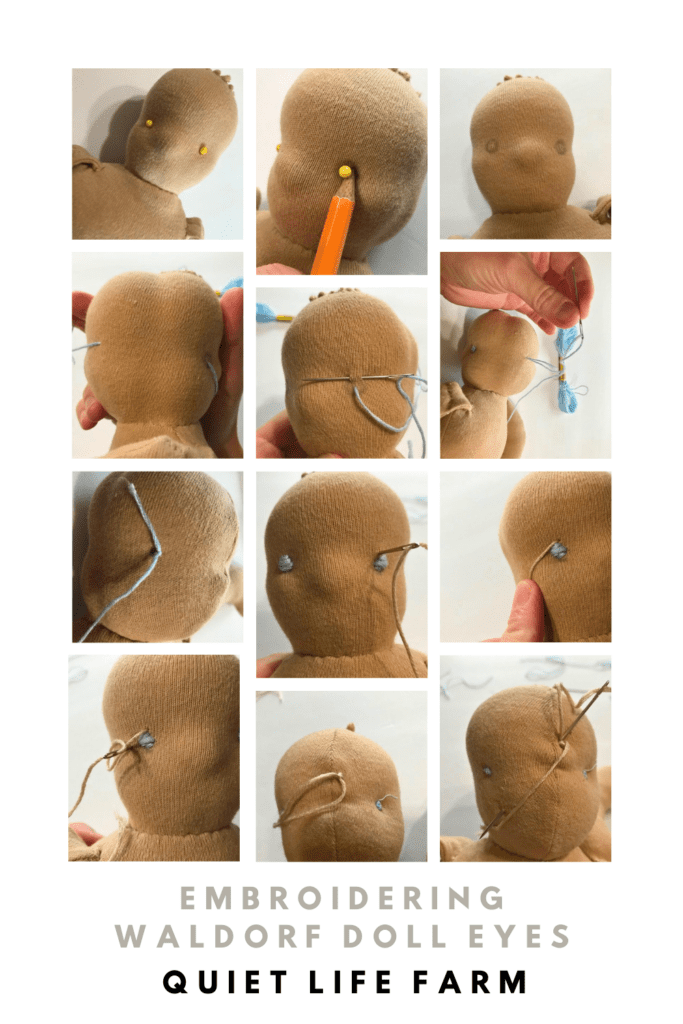
Now that the doll’s body is assembled, let’s embroider the eyes.
Put two straight pins into the doll right where you want the eyes to go.
Use a pencil to draw a circle around the pins.
Take the pins out.
Thread a dollmaking needle with embroidery thread.
You really want to use a LONG thick needle for this so it can reach all the way through the doll’s head without getting lost inside your doll.
From front to back, stick the threaded needle into the center of the eye.
Pull a little tail of embroidery floss out through the back of the head.
Re thread the long end of embroidery floss coming out of the front of the eye wiht an embroidery needle.
Make stitches from right to left to embroider an eye, using your circle as a guide.
Make your final stitch by rethreading your working floss to your dollmaking needle, and pull the rest of the thread to the back of the head.
Tie a knot wiht th etow pieces of floss in the back of the head, then hide the floss inside the head so it isn’t seen.
Repeat for a second eye.
Embroider eyelids right over the eye with your long dollmaking needle. Start at the top inner corner of the eye, and pull the floss all the way to the back of the head. Leave a little tail.
With the end of the embroidery floss at the front of the eye, rethread your dollmaking needle, decide where you want your eyelid to end (at the bottom outer corner, plus a little farther away from the eye) and stick the needlt through to the back of the head.
Tie a knot and weave in your ends.
Lastly, embroider a little mouth.
Thread your dollmaking needle with embroidery floss. Stick the needle through to the back of the head.
Then, with the floss in the front, rethread your dollmaking needle, make a little mouth, and stick your needle back to the head. Come out with your needle close to your first “mouth stitch,” tie a knot, and weave in your ends.
Hair

Grab some worsted weight (weight 4) yarn that (relatively closely) matches the hair color you plan to use for your doll.
We’re going to crochet a cap to help attach the hair to our doll.
With a 6.5mm crochet hook, chain 3 stitches. Stick your hook into your first chain, and slip to join.
With your 3 chains, you’ve created a little circle. In the center of that circle, make 8 double crochets, then slip into the first double crochet to join. Chain 1. (continue slipping to join, then chain 1, at the end of each round)
Next row: Two double crochet stitches in each each stitch.
Next row: (1 Double crochet in the first stitch, 2 Double Crochets in the next stitch). Repeat around.
Next row: (1 Double Crochet in each of the first two stitches, 2 Double Crochets into the third stitch). Repeat around.
Final row: (1 Double Crochet in each of the first three stitches, 2 Double Crochets into the fourth stitch). Repeat around. Slip to join, cut your yarn and secure your ends.
Sewing on the Hair
Next, I’ll walk you through how to attach hair to your doll.
If you want to use yarn hair, sew the cap on the head, then weave and tie individual yarn strands of hair through the cap.
I have a more detailed post on how to attach yarn hair to your doll here.
I also have a post on how to make your own weft here.
If you’re using a weft, start by pinning the first layer on hair UNDER the cap.
Pin it all in place with straight pins. Then start sewing the hair onto your doll.
Make sure while you’re sewing the hair onto your doll that you go through 3 layers — the cap, the hair, and the doll’s head!
Use a thread color similar to the hair color so it blends in well.
Continue going around the head attaching the hair in a “circle.” For the second layer and rest of the layers, you’ll want to sew it directly on the cap.
You don’t have to pin the hair the rest of the way.
Once you reach the end of the hair, you should be at the top center of the head. Sew a nice strong knot, then cut off any excess weft.
Weave in all your ends of thread.
Final Features and CLOTHES
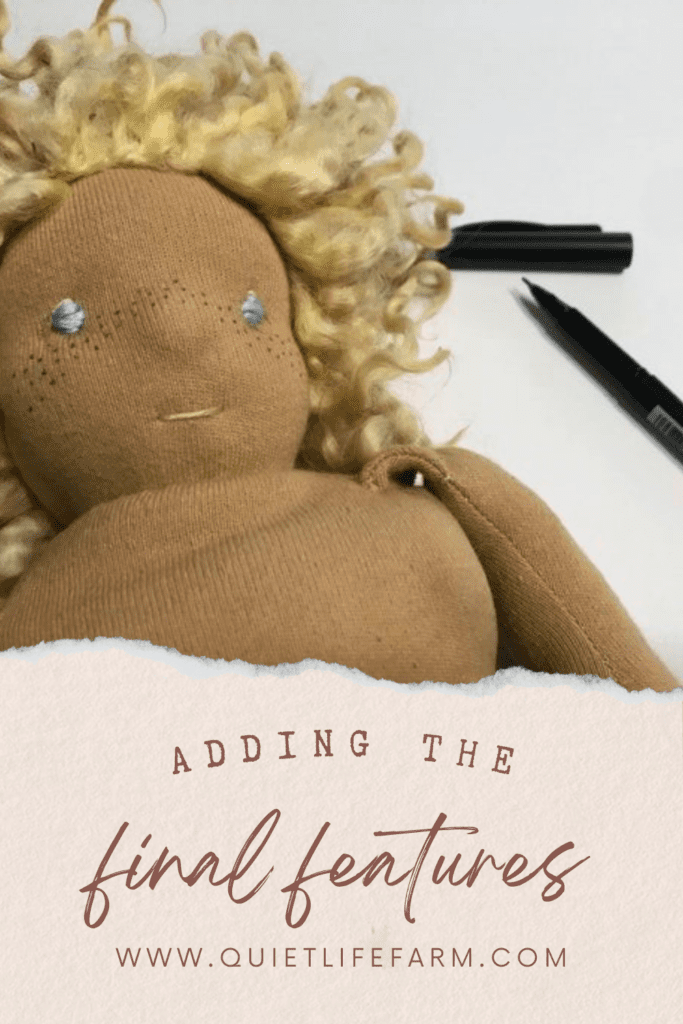
If you’d like to add freckles and blush to your doll, do that now.
For the freckles, I used a super fine permanent marker in black.
Wait for the ink to dry ENTIRELY, and then a little extra time just to be sure. Only then blush your doll — you don’t want the ink to smudge all over your nearly finished doll!
I used a red crayon from my kids’ crayon box to blush this doll. Like a total pro. Natural beeswax crayons are a much more traditional (and probably better) way to do this.
AFTER you blush your doll and add any freckles, use a ladder stitch to attach the ears to the doll.
I positioned the ears on this doll slightly above the eyeline.
Use a ladder stitch on both the front of the ear and the back of the ear.
Weave in all your ends.
Clothes
For clothes, I used the shirt and pants patterns on my Waldorf Gnome Doll pattern.
This pattern is also free for you to print!
I did modify the pattern a bit — I made the shirt a bit wider at the sleeves so I could add elastic to the wrists. I also made the shirt a bit longer (and wider) so that it functions more like a dress.
Lastly, I tied some ribbon around the waist of the doll to match the ribbons in her hair.
Leave a Comment
I would love to hear from you below!
Let me know how your dollmaking journey went.
If you’re interest in other Waldorf doll patterns, please look around on my website for a bit!
I love offering up free Waldorf doll patterns to other mamas, so they can have the opportunity to make dolls for their children, too — without breaking the bank!
Happy dollmaking!
